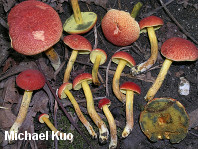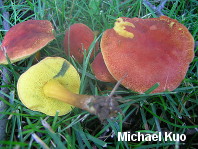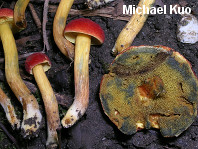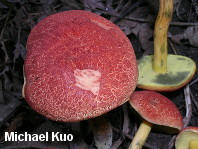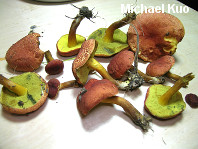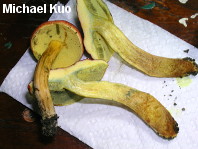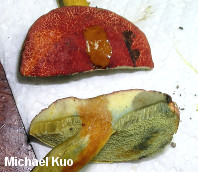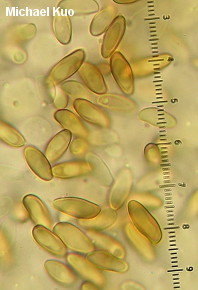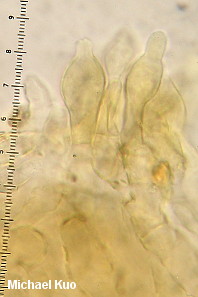| Major Groups > Boletes > Red-Capped, Blue Staining > Boletus harrisonii |

|
Boletus harrisonii [ Basidiomycota > Boletales > Boletaceae > Boletus . . . ] by Michael Kuo Among my collections of small, red-capped, blue-staining boletes, Boletus harrisonii is by far the most common; look-alikes Xerocomellus rubellus and Boletus campestris appear to be much less frequently found, despite the fact that they appear in field guides while Boletus harrisonii does not. Separating Boletus harrisonii from these two species can be accomplished fairly handily by examining the flesh in the stem base (in young, fresh specimens), since Boletus campestris and Xerocomellus rubellus feature tiny red to orange dots in the stem base, while Boletus harrisonii does not--but microscopic examination of the pileipellis (the outermost "skin" of the cap surface) is required for a more confident identification; Boletus harrisonii features a yellow-in-KOH palisadoderm. To separate Boletus harrisonii from other look-alikes, see the key to red-capped, blue-staining boletes. Using the generic concepts of Šutara (2008), Boletus harrisonii should probably be placed in Xerocomellus. Description: Ecology: Mycorrhizal with hardwoods (especially oaks) and with spruces; growing alone, scattered, or gregariously, in woods or, frequently, at their edges, in parks and gardens; summer and fall; probably widely distributed east of the Rocky Mountains. The illustrated and described collections are from Illinois and Minnesota. Cap: 2-6 cm; convex, becoming broadly convex in age; dry; bald or finely velvety; red to dark red or dark brick red; fading to reddish or nearly tan; the surface usually becoming finely but prominently cracked at maturity. Pore Surface: Often becoming depressed at the stem; yellow at first, becoming dull olive yellow; bruising promptly blue and then, over time, brown; with 1-3 angular pores per mm; tubes to about 1 cm deep. Stem: 4-8 cm long; 0.5-1 cm thick; more or less equal, or very slightly tapered to the base; often twisted; yellow above, orangish yellow to reddish below; bald or pruinose; not reticulate; basal mycelium pale yellow. Flesh: Pale yellow; staining blue (sometimes faintly and erratically) when sliced, especially over the tubes. Odor and Taste: Not distinctive. Chemical Reactions: Ammonia negative on cap surface; negative (but erasing blue) on flesh. KOH yellow to dull orange on cap surface; dull orange on flesh. Iron salts gray to nearly black on cap; gray or negative on flesh. Spore Print: Olive brown. Microscopic Features: Spores 9-13 x 4-5 µ; subfusiform; smooth; yellow in KOH; dull reddish brown in Melzer's. Hymenial cystidia lageniform; to about 60 x 15 µ. Pileipellis a palisadoderm of sometimes-encrusted elements that vary from cylindric, 2.5-10 µ wide, to barrel-shaped or subglobose and somewhat inflated (to 17.5 µ wide); terminal cells with rounded or subacute apices, or obnapiform, capitate, or cystidioid; yellow in KOH; reddish brown in Melzer's. REFERENCES: Smith & Thiers, 1971. (Smith, Smith & Weber, 1981; Both, 1993.) Herb. Kuo 07200202, 08010202, 07160302, 07120804, 06081002, 09071204. This site contains no information about the edibility or toxicity of mushrooms. |
© MushroomExpert.Com |
|
Cite this page as: Kuo, M. (2014, December). Boletus harrisonii. Retrieved from the MushroomExpert.Com Web site: http://www.mushroomexpert.com/boletus_harrisonii.html |
